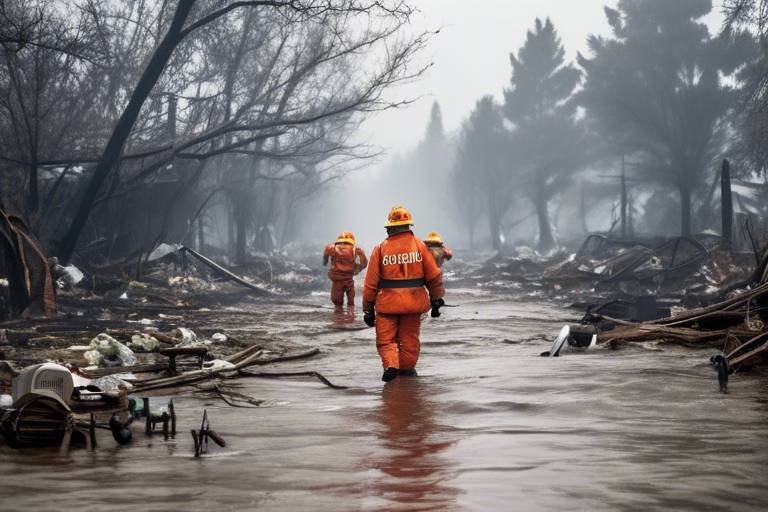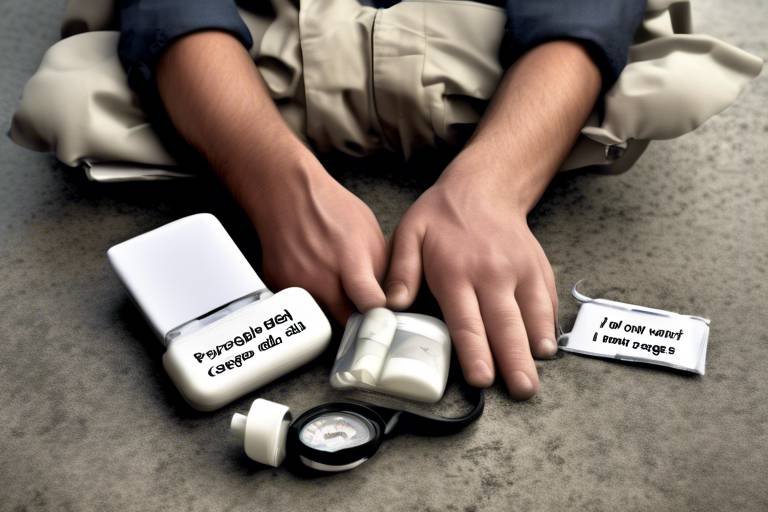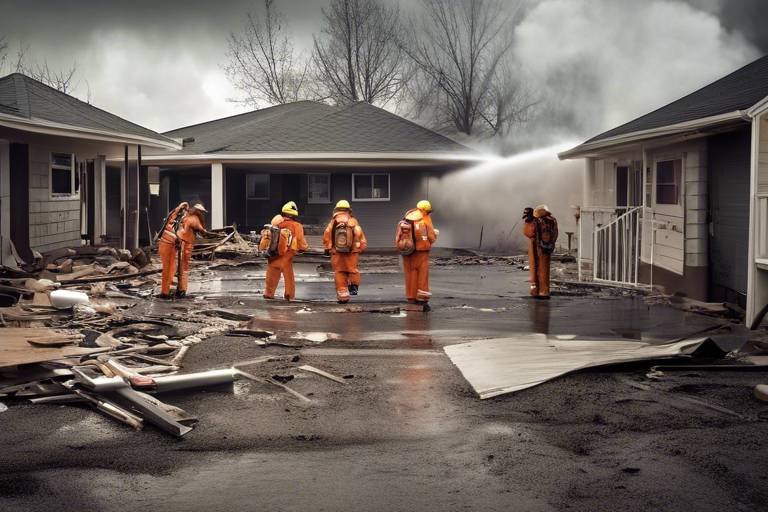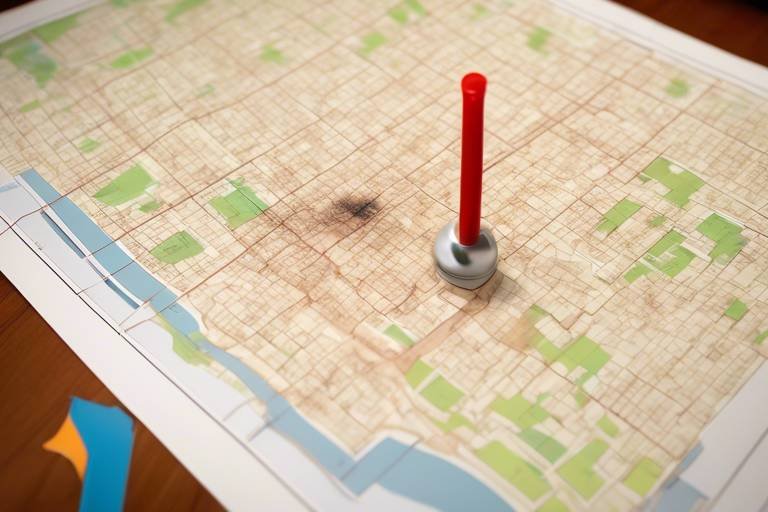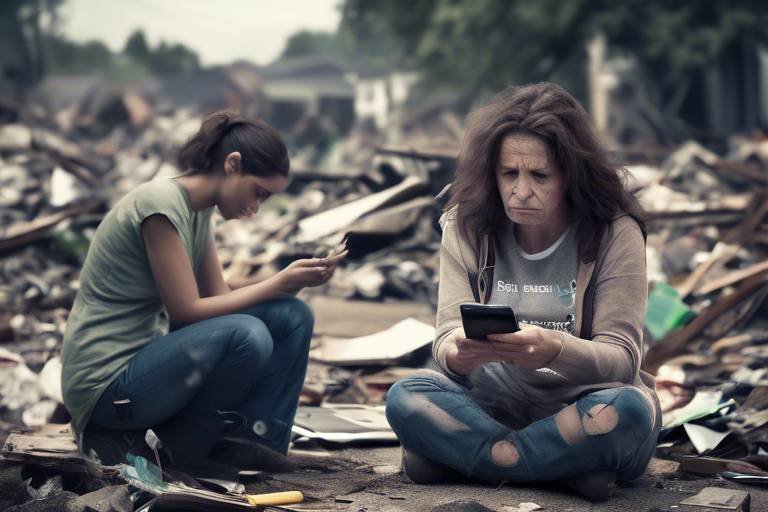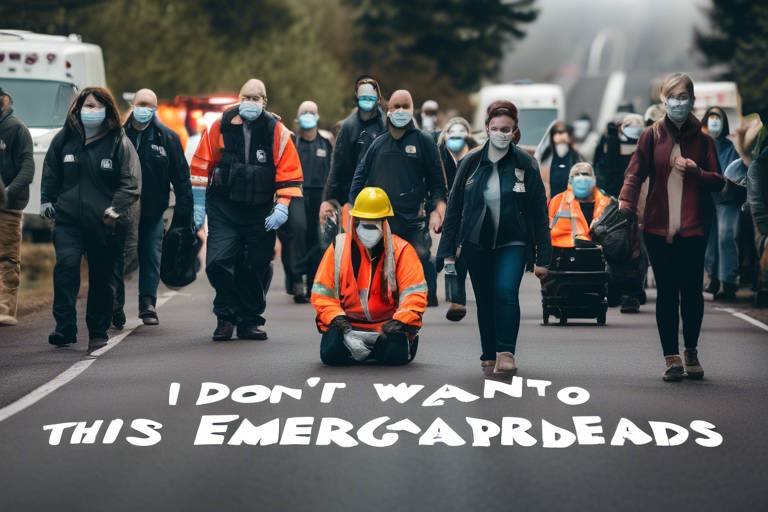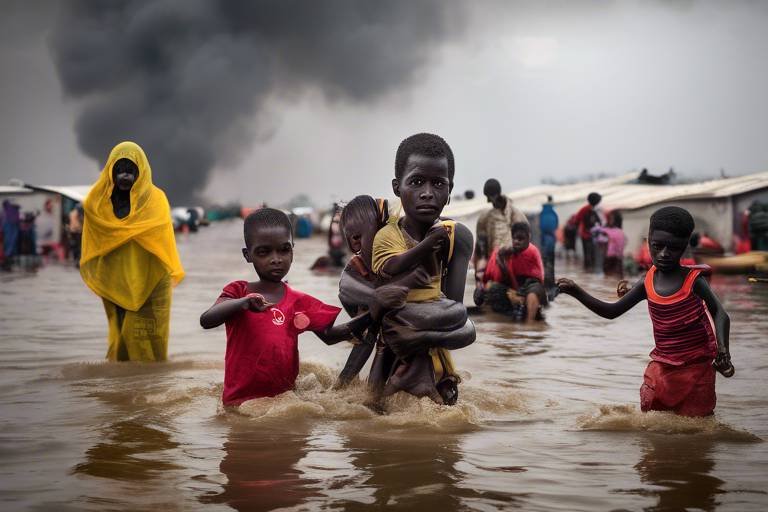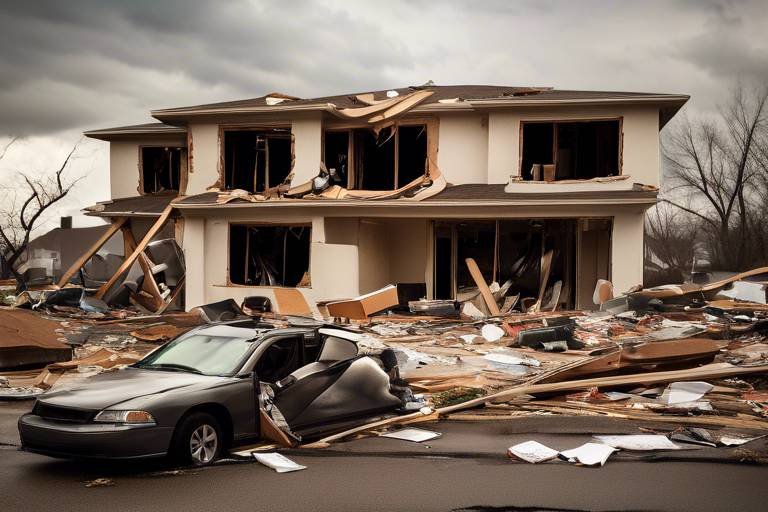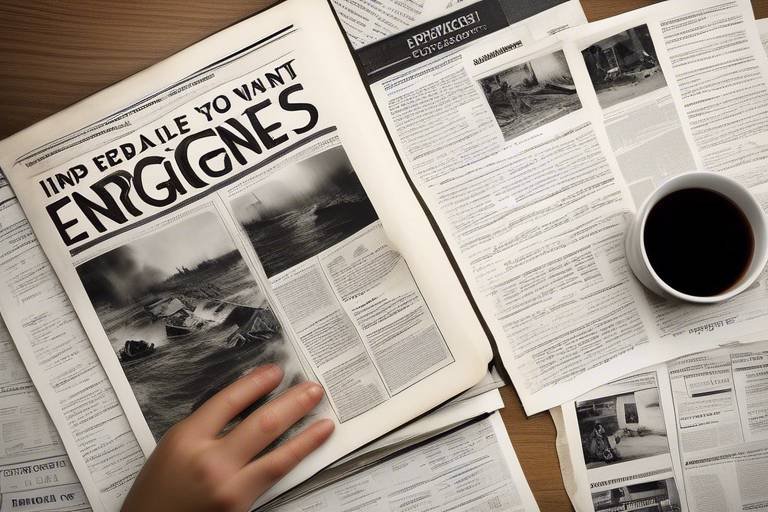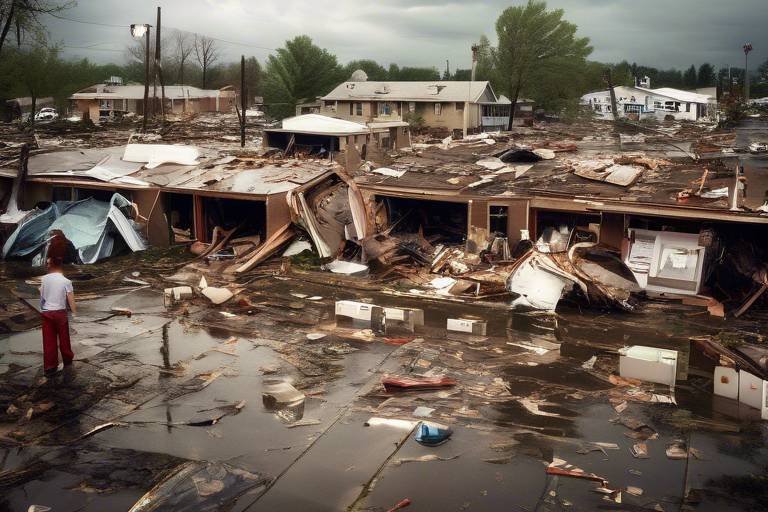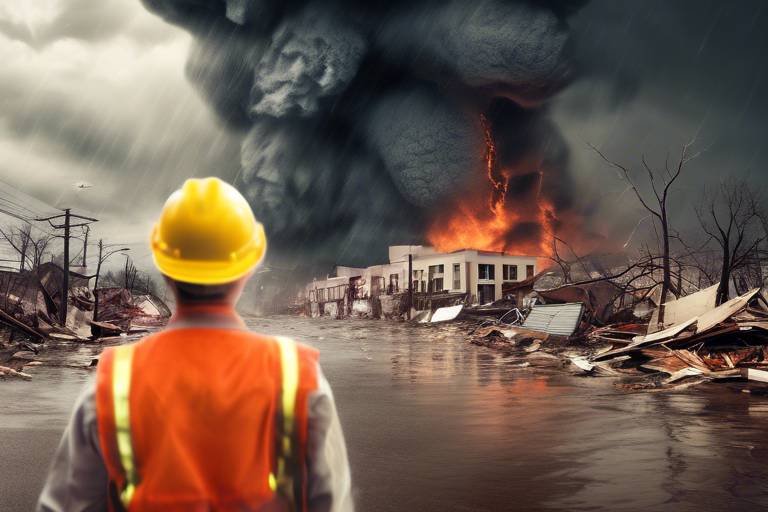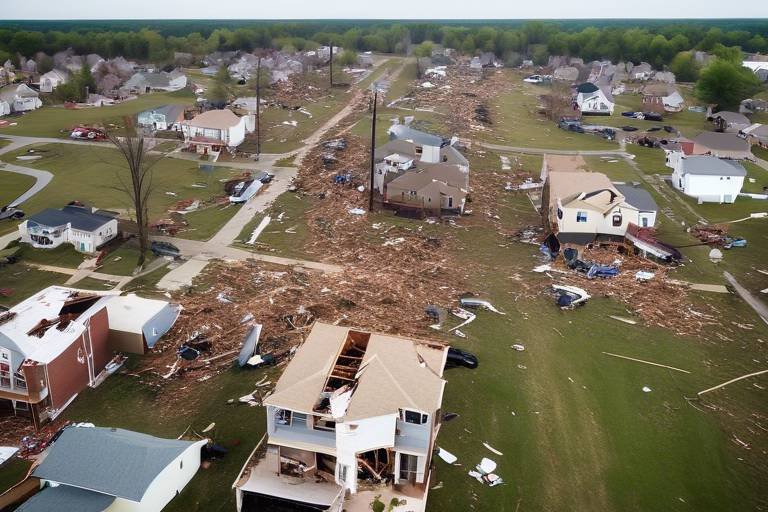Managing Stress and Anxiety during Disasters
Disasters can strike at any moment, often leaving us feeling overwhelmed and anxious. The chaos that ensues can trigger a whirlwind of emotions, from fear to confusion, making it crucial to find effective ways to manage stress and anxiety during such turbulent times. This article explores practical strategies that not only address mental health but also promote resilience through self-care techniques and community support systems. By understanding how to cope effectively, we can navigate through the storm and emerge stronger on the other side.
To effectively manage stress and anxiety during disasters, it’s essential to first comprehend what these terms mean and how they differ. Stress is typically a response to an external trigger—a disaster, for instance—that prompts feelings of tension or pressure. In contrast, anxiety is more about the internal feelings of apprehension and worry that can persist even after the immediate threat has passed. During disasters, these feelings can manifest in various ways, affecting not just mental health but overall well-being. Recognizing these feelings is the first step toward coping effectively.
Disasters have a profound psychological impact on individuals. The aftermath can lead to feelings of trauma, grief, and heightened anxiety. It's important to acknowledge these feelings as normal reactions to abnormal situations. Ignoring them can lead to long-term mental health issues, such as chronic anxiety or depression. Understanding that these feelings are valid and common can be the first step towards recovery. It’s like being caught in a storm; acknowledging that the storm exists is essential before you can find shelter.
After a disaster, individuals often experience a range of emotional responses, including:
- Shock: This initial reaction can leave individuals feeling numb and disoriented.
- Confusion: Uncertainty about what to do next can lead to feelings of helplessness.
- Fear: A heightened sense of fear may persist, impacting daily routines and interactions.
These reactions are completely normal and should not be brushed aside. It’s crucial to allow yourself to feel these emotions, as they are part of the healing process.
The effects of disasters can linger long after the event itself. Many individuals may develop conditions such as Post-Traumatic Stress Disorder (PTSD) or chronic anxiety. The need for ongoing support cannot be overstated—just as a plant needs sunlight and water to grow, our mental health requires nurturing and care. Acknowledging these long-term effects and seeking help is vital for recovery.
Recognizing the signs of stress and anxiety is crucial for timely intervention. Some common symptoms include:
- Increased heart rate
- Difficulty concentrating
- Sleep disturbances
- Changes in appetite
If you notice these symptoms in yourself or others, it may be time to seek help. Just like a car that makes strange noises needs a mechanic, our mental health requires attention when something feels off.
Resilience is the ability to bounce back from adversity. Building personal and community resilience is essential during disasters. This can be achieved through adaptive coping strategies, such as maintaining a routine, staying connected with loved ones, and participating in community support networks. Think of resilience as a rubber band; the more you stretch it, the stronger it becomes.
Effective self-care can significantly alleviate stress and anxiety during disasters. Here are some practical tips:
- Mindfulness: Practicing mindfulness helps center your thoughts and calm your mind.
- Physical Activity: Engaging in regular exercise can boost your mood and reduce anxiety.
- Healthy Routine: Maintaining a structured daily routine can provide a sense of normalcy amid chaos.
Implementing these strategies can be as refreshing as a cool breeze on a hot day, providing relief and clarity when you need it most.
Mindfulness and relaxation techniques are powerful tools for reducing anxiety. Methods such as meditation, deep breathing exercises, and yoga can help promote calmness and mental clarity. Think of these practices as a mental spa day; they allow you to unwind and recharge your emotional batteries.
Sometimes, the weight of stress and anxiety can feel too heavy to bear alone. Seeking professional help is not a sign of weakness; in fact, it’s a courageous step towards healing. If you find yourself struggling to cope, don’t hesitate to reach out to mental health professionals. They can provide the support and guidance you need to navigate through difficult times.
Q: What are the first signs of stress and anxiety during a disaster?
A: Common signs include heightened emotional responses, difficulty concentrating, and physical symptoms like increased heart rate.
Q: How can I support someone dealing with anxiety after a disaster?
A: Listen to them, provide reassurance, and encourage them to seek professional help if needed.
Q: When should I seek professional help?
A: If stress and anxiety interfere with daily life or persist for an extended period, it’s time to consult a mental health professional.

Understanding Stress and Anxiety
When we talk about stress and anxiety, it’s essential to understand that while they are often used interchangeably, they are not the same. Stress is typically a response to an external trigger, such as a looming deadline or a natural disaster, which can provoke feelings of tension and pressure. On the other hand, anxiety is more of a persistent feeling that can linger even after the stressor has passed. Think of stress as a temporary storm that passes through your life, while anxiety is like the overcast sky that seems to hang around long after the storm has gone.
During disasters, both stress and anxiety can manifest in various ways. You might find yourself feeling overwhelmed, irritable, or even physically affected with symptoms like headaches or stomach issues. These reactions are completely normal, and understanding them is the first step toward managing your mental health effectively. It’s like being in a crowded room where everyone is shouting; it can be challenging to hear your own thoughts. Recognizing that this chaos is a natural response can help you regain a sense of control.
Moreover, the impact of stress and anxiety during disasters can be profound. They can affect not only your mental health but also your overall well-being. When faced with a disaster, it’s common to experience heightened emotions such as fear, sadness, and confusion. These feelings are part of our human experience, and acknowledging them can pave the way for healing. Think of it this way: just as a plant needs water and sunlight to grow, we need to nurture our emotional health by recognizing our feelings and seeking support when necessary.
To further illustrate the differences between stress and anxiety, consider the following table:
| Aspect | Stress | Anxiety |
|---|---|---|
| Definition | Response to an external trigger | Persistent worry or fear |
| Duration | Short-term | Long-term |
| Symptoms | Tension, irritability, headaches | Restlessness, racing thoughts, sleep issues |
| Triggers | Specific events or situations | Generalized worries about the future |
Understanding these differences can empower you to take proactive steps in managing your mental health. If you find yourself feeling overwhelmed, it’s essential to reach out for help. Just like a lighthouse guides ships through turbulent waters, seeking support can illuminate your path through the storm of emotions you may be experiencing.
In conclusion, recognizing the nuances of stress and anxiety is vital, especially during disasters. By understanding how these feelings manifest and impact our lives, we can better equip ourselves to handle challenging situations. Remember, it’s okay to seek help and take care of your mental health; it’s a sign of strength, not weakness.

The Psychological Impact of Disasters
Disasters, whether natural or man-made, can turn our lives upside down in an instant. The psychological impact of such traumatic events is profound and far-reaching, affecting not only individuals directly involved but also their families and communities. When we think about disasters, we often visualize the physical destruction—homes destroyed, landscapes altered, lives lost. However, the emotional toll can be equally devastating, manifesting in various ways that can linger long after the immediate crisis has passed.
During disasters, it’s common for individuals to experience a range of psychological effects. Many may find themselves grappling with feelings of trauma and grief, which can lead to heightened levels of anxiety. The chaos and unpredictability of such events can trigger a fight-or-flight response, leaving people feeling on edge and hyper-vigilant. It’s essential to acknowledge that these feelings are not just normal reactions but also a critical part of the recovery process. When we allow ourselves to feel and express these emotions, we pave the way for healing.
One of the most significant psychological impacts of disasters is the onset of conditions like Post-Traumatic Stress Disorder (PTSD). Individuals may relive the traumatic event through flashbacks or nightmares, causing them to feel as though they are experiencing the disaster all over again. This can lead to a cycle of fear and avoidance, where individuals may withdraw from social interactions or refrain from engaging in activities they once enjoyed. The importance of recognizing these symptoms cannot be overstated; timely intervention can make a substantial difference in the recovery journey.
After a disaster, it's not uncommon for individuals to experience a whirlwind of emotions. Some of the most frequently observed reactions include:
- Shock: A sense of disbelief that the event has occurred.
- Confusion: Difficulty processing what has happened and what it means for the future.
- Fear: An overwhelming sense of worry about safety and the unpredictability of life moving forward.
These reactions are entirely normal and should not be stigmatized. In fact, they are a part of the body’s natural response to trauma. It’s essential for individuals to understand that they are not alone in their feelings and that seeking support is a strong step towards healing.
The aftermath of a disaster can lead to long-term mental health issues, including chronic anxiety and PTSD. Research shows that individuals who experience significant trauma may carry these burdens for years, affecting their quality of life. It’s crucial to recognize that recovery is not a linear process; there will be ups and downs along the way. Continuous support from friends, family, and mental health professionals plays a vital role in helping individuals navigate these challenges.
Recognizing the symptoms of stress and anxiety is a vital step in addressing mental health needs. Common signs include:
- Persistent sadness or hopelessness
- Excessive worry about everyday situations
- Physical symptoms such as headaches, stomach issues, or fatigue
- Difficulty concentrating or making decisions
Being aware of these symptoms allows individuals to seek help when needed, ensuring they don’t have to face their struggles alone.
In conclusion, the psychological impact of disasters is profound and multifaceted. Understanding the emotional responses that come with such events is crucial for recovery. By acknowledging feelings of trauma, grief, and anxiety, individuals can take the first steps toward healing. Remember, it’s okay to seek help and lean on others during these challenging times.
Q: What should I do if I feel overwhelmed after a disaster?
A: It’s essential to talk about your feelings with someone you trust. Seeking professional help can also provide you with coping strategies and support.
Q: How long does it take to recover from the psychological impact of a disaster?
A: Recovery varies for everyone; some may heal in months, while others may take years. It’s important to be patient with yourself and seek support throughout the process.
Q: Are there any community resources available for mental health support after a disaster?
A: Yes, many communities offer resources such as counseling services, support groups, and crisis hotlines. Check with local organizations or mental health professionals for available options.
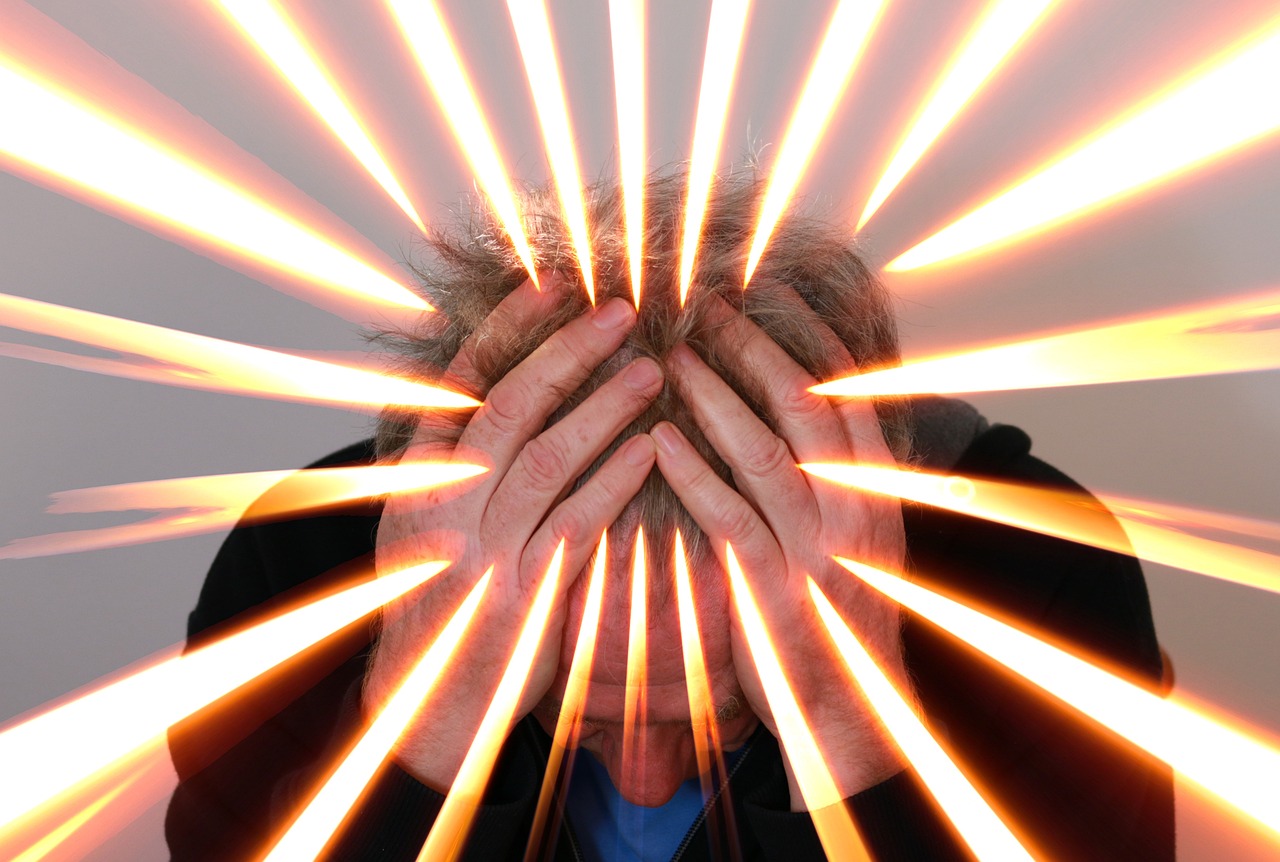
Common Reactions to Disasters
When disasters strike, it's not just the physical damage that takes a toll; the emotional and psychological impacts can be equally devastating. People often find themselves in a whirlwind of feelings, and it's completely normal to experience a range of reactions. Imagine standing in the eye of a storm—everything around you is chaotic, yet you're trying to make sense of it all. This is how many individuals feel during and after a disaster.
One of the most common initial reactions is shock. This feeling can leave individuals feeling numb or detached, almost as if they're watching the events unfold from a distance. It's a natural defense mechanism that allows the mind to process overwhelming situations at its own pace. Alongside shock, many people experience confusion. Suddenly, the world they knew is turned upside down, and they struggle to comprehend what has happened and what comes next.
Then there's the ever-present emotion of fear. Fear can manifest in various ways—fear for personal safety, fear for loved ones, or even fear of the unknown future. This heightened state of anxiety can lead to physical symptoms such as a racing heart or difficulty breathing. In many cases, these feelings are compounded by a sense of loss, whether it's the loss of a home, community, or even a loved one.
It’s essential to recognize that these reactions are not only common but also a part of the human experience during crises. Individuals may find themselves oscillating between feelings of anger, sadness, and even guilt. It’s like being on an emotional rollercoaster, where one moment you feel hopeful, and the next, despair takes over. Acknowledging these feelings is vital for recovery; they are valid responses to an invalid situation.
Furthermore, individuals might also experience flashbacks or intrusive thoughts about the disaster, which can be disorienting and distressing. These reactions can linger long after the immediate crisis has passed, often leading to prolonged mental health challenges. Therefore, understanding these common reactions is the first step toward healing.
In summary, while the emotional fallout from disasters can be intense and varied, it’s crucial to remember that you're not alone in your feelings. Many people share similar experiences, and recognizing these common reactions can pave the way for seeking support and finding a path to recovery. Just as storms eventually pass, so too can the emotional turmoil, especially when individuals lean on their support systems and seek help when needed.
- What should I do if I feel overwhelmed after a disaster? It's important to talk to someone you trust, whether it's a friend, family member, or mental health professional. Acknowledging your feelings is the first step towards healing.
- How long do these reactions typically last? Reactions can vary greatly among individuals. Some may feel better within weeks, while others may experience symptoms for months or even years.
- Are there specific support groups for disaster survivors? Yes, many organizations offer support groups specifically for individuals who have experienced disasters. Connecting with others who have shared similar experiences can be incredibly healing.
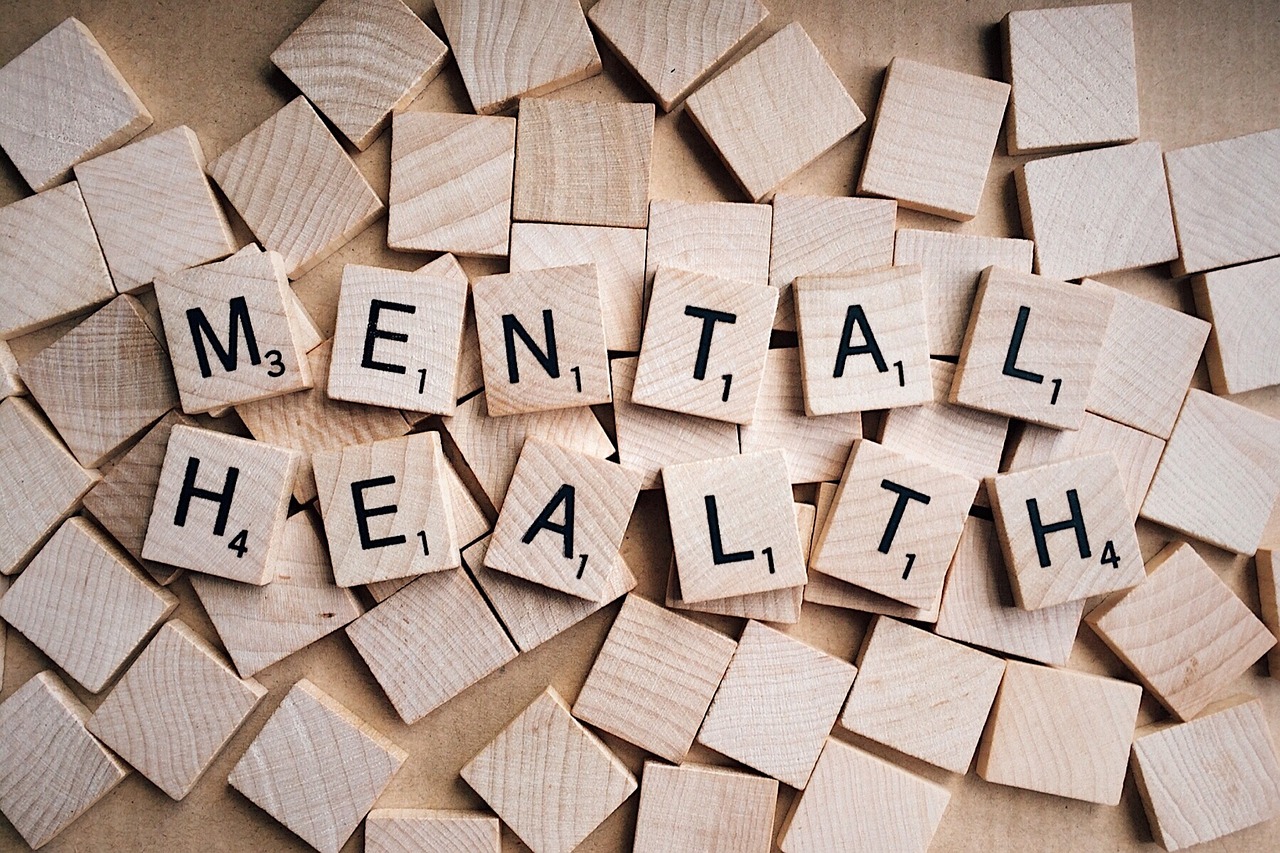
Long-term Effects on Mental Health
When disasters strike, the immediate chaos can be overwhelming, but the long-term effects on mental health can be just as profound, if not more so. Many individuals find themselves grappling with issues like Post-Traumatic Stress Disorder (PTSD), chronic anxiety, and even depression long after the initial event has passed. It’s crucial to understand that these reactions are not only normal but also a significant part of the healing process.
PTSD, for instance, can manifest in various ways. People may experience flashbacks, nightmares, or severe anxiety, which can interfere with daily life. According to studies, nearly 7-8% of the population will experience PTSD at some point in their lives, and the rates can be higher in those who have faced traumatic events, such as natural disasters. The emotional aftermath can linger, creating a cycle of distress that is hard to break.
Moreover, chronic anxiety and depression can lead to a range of physical health issues, including heart problems, weakened immune systems, and digestive issues. This connection between mental health and physical well-being highlights the importance of addressing mental health needs promptly and effectively. The body and mind are intricately linked, and when one suffers, the other often does as well.
It's also important to acknowledge that individuals may react differently to disasters. While some may exhibit resilience, others may struggle significantly. Factors such as previous trauma, personal coping mechanisms, and the presence of a supportive community can influence outcomes. The following table summarizes some common long-term effects of disasters on mental health:
| Long-term Effect | Description |
|---|---|
| PTSD | Re-experiencing the trauma through flashbacks or nightmares. |
| Chronic Anxiety | Persistent feelings of worry or fear that disrupt daily activities. |
| Depression | Feelings of hopelessness and a lack of interest in previously enjoyed activities. |
| Substance Abuse | Increased reliance on drugs or alcohol as a coping mechanism. |
| Social Withdrawal | A tendency to isolate oneself from friends and family, leading to loneliness. |
Recognizing these symptoms is the first step in seeking help. It’s essential for individuals affected by disasters to be aware of their mental health and to reach out for support when needed. Therapy, support groups, and community resources can play a vital role in recovery. Remember, it's okay to ask for help—doing so can be a sign of strength, not weakness.
In conclusion, the long-term effects of disasters on mental health can be significant and varied. Awareness and early intervention are key to navigating these challenges. By fostering a supportive environment and encouraging open discussions about mental health, we can help ourselves and others heal from the scars left by traumatic events.

Identifying Symptoms of Stress and Anxiety
Recognizing the symptoms of stress and anxiety is crucial for anyone navigating the tumultuous waters of a disaster. These feelings can often sneak up on you, manifesting in ways that might not be immediately obvious. It's like trying to spot a hidden iceberg while sailing through foggy seas; you might only see the tip of the issue until it becomes a much larger problem. Understanding these symptoms can empower you to take action before things escalate.
Stress and anxiety can present themselves in various forms, both physically and emotionally. Physically, you might notice changes such as increased heart rate, sweating, or even gastrointestinal issues. Emotionally, stress can lead to feelings of irritability, sadness, or a sense of being overwhelmed. It’s important to pay attention to these signals from your body and mind. If you find yourself feeling unusually tired or unable to concentrate, it may be a sign that your stress levels are higher than they should be.
Here are some common symptoms to look out for:
- Physical Symptoms: Headaches, muscle tension, fatigue, and changes in sleep patterns.
- Emotional Symptoms: Feelings of hopelessness, irritability, or excessive worry.
- Cognitive Symptoms: Difficulty concentrating, indecisiveness, or constant worrying.
It's also worth noting that everyone reacts differently to stress and anxiety. Some people may become withdrawn, while others might lash out in frustration. This variability can make it challenging to gauge when someone needs help, including yourself. If you find that these symptoms persist and start to interfere with your daily life, it could be time to seek support. Remember, acknowledging these feelings is a vital step toward healing and recovery.
In conclusion, identifying the symptoms of stress and anxiety is not just about recognizing what you feel; it's about understanding that these feelings are valid and worthy of attention. By staying attuned to your emotional and physical state, you can take proactive steps to address these challenges, ensuring that you remain resilient in the face of adversity.
Q: What are the most common symptoms of stress and anxiety?
A: Common symptoms include physical signs like headaches and fatigue, emotional signs such as irritability and sadness, and cognitive signs like difficulty concentrating.
Q: How can I differentiate between stress and anxiety?
A: Stress is usually a response to an external trigger, while anxiety often persists even after the stressor is removed. However, both can have overlapping symptoms.
Q: When should I seek professional help for stress and anxiety?
A: If symptoms are severe, persistent, or interfering with daily life, it’s important to consult a mental health professional for guidance and support.

Building Resilience
Building resilience is like constructing a sturdy bridge over a turbulent river. When disasters strike, that bridge allows us to navigate the chaos and emerge stronger on the other side. Resilience isn't just an innate trait; it's a skill that can be developed through practice and the right mindset. It involves adapting to challenging situations, bouncing back from setbacks, and maintaining a sense of hope even when the future seems uncertain. So, how do we cultivate this vital quality?
First and foremost, it's essential to foster a supportive environment. Surrounding ourselves with positive influences—friends, family, and community members—can make a world of difference. Think of your support network as a safety net that catches you when you fall. Engaging in open conversations about feelings and experiences during disasters can help normalize the emotional responses we have. It’s okay to feel overwhelmed; what matters is how we respond to those feelings.
Another crucial aspect of resilience is developing adaptive coping strategies. These strategies can vary from person to person, but they often include practices such as problem-solving, seeking social support, and maintaining a sense of purpose. For instance, when faced with a disaster, instead of succumbing to despair, one might focus on actionable steps to improve their situation. This proactive approach not only helps in managing stress but also empowers individuals to take control of their circumstances.
Moreover, resilience is closely linked to emotional regulation. Learning to manage our emotions during turbulent times can be incredibly beneficial. Techniques such as journaling, where you express your thoughts and feelings, can serve as an emotional outlet. It’s like talking to a friend who always listens without judgment. Additionally, practicing gratitude, even in the face of adversity, can shift our mindset from what we’ve lost to what we still have. A simple daily practice of noting three things you’re grateful for can foster a more positive outlook.
Finally, it's important to remember that building resilience is a journey, not a destination. Just like physical fitness, it requires consistent effort and self-compassion. We should celebrate our small victories and learn from our setbacks. Embracing the idea that it’s okay to ask for help is also crucial. Whether it’s from loved ones or professional support, reaching out can provide the necessary tools to enhance our resilience.
In summary, building resilience involves creating a supportive environment, developing adaptive coping strategies, regulating emotions, and practicing self-compassion. By focusing on these areas, we can strengthen our ability to face disasters and emerge from them with newfound strength and clarity.
- What is resilience? Resilience is the ability to bounce back from difficult situations and adapt positively to challenges.
- How can I build resilience? You can build resilience by fostering supportive relationships, developing coping strategies, and practicing emotional regulation.
- Why is resilience important during disasters? Resilience helps individuals manage stress and anxiety, enabling them to navigate challenges more effectively and recover from setbacks.
- Can resilience be learned? Yes, resilience can be developed through practice, support, and a positive mindset.

Self-Care Strategies
In times of crisis, when the world feels like it's spinning out of control, self-care becomes not just a luxury but a necessity. It's like putting on your oxygen mask before helping others—if you’re not okay, you can’t be there for anyone else. So, how do we prioritize our well-being amidst chaos? The answer lies in a variety of self-care strategies that can help alleviate stress and anxiety. Think of them as your personal toolkit for resilience, designed to help you navigate the stormy seas of disaster.
First and foremost, establishing a daily routine can provide a sense of normalcy. When everything around you feels uncertain, having a structure can be incredibly grounding. This routine doesn’t have to be rigid; it can include simple activities such as waking up at the same time each day, setting aside time for meals, and scheduling moments for relaxation or hobbies. Even small, consistent actions can create a comforting rhythm in your life.
Another effective strategy is to engage in physical activity. Exercise is like a natural stress reliever; it releases endorphins, which are chemicals in your brain that act as natural painkillers and mood elevators. Whether it’s a brisk walk, a yoga session, or dancing around your living room, moving your body can significantly reduce feelings of anxiety. Aim for at least 30 minutes of physical activity most days of the week, and you’ll likely notice a boost in your mood and overall well-being.
Don’t underestimate the power of mindfulness and relaxation techniques. These practices are like a mental reset button, allowing you to step back from overwhelming emotions and regain control. Techniques such as meditation, deep breathing exercises, or progressive muscle relaxation can be incredibly beneficial. For instance, try this simple breathing exercise: inhale deeply for a count of four, hold for four, and exhale for four. Repeat this cycle a few times, and you may find your anxiety dissipating.
Moreover, maintaining social connections is crucial during challenging times. Humans are inherently social beings, and reaching out to friends and family can provide emotional support that is invaluable. Whether it's a quick text, a phone call, or a video chat, sharing your feelings with someone you trust can lighten the emotional load. Remember, it’s perfectly okay to lean on others—you’re not alone in this.
Finally, make sure to prioritize adequate sleep and nutrition. Sleep is your body’s way of healing, and without it, stress levels can skyrocket. Aim for 7-9 hours of quality sleep each night. Pair that with a balanced diet rich in fruits, vegetables, whole grains, and lean proteins, and you’ll be giving your body the fuel it needs to cope with stress. It’s like providing your car with premium gas; you wouldn’t expect it to run smoothly on empty!
In summary, self-care is not just about pampering yourself; it’s about nurturing your mental and physical health during tough times. By establishing a routine, engaging in physical activity, practicing mindfulness, maintaining social connections, and prioritizing sleep and nutrition, you can build a strong foundation for resilience. Remember, it’s okay to take a step back and focus on yourself. After all, in the grand scheme of things, your well-being is the first step towards recovery.
- What is self-care? Self-care refers to the activities and practices that we engage in to maintain our physical, mental, and emotional health.
- Why is self-care important during disasters? It helps to manage stress and anxiety, allowing individuals to cope better with the challenges they face.
- Can mindfulness really help reduce anxiety? Yes, mindfulness practices can significantly reduce anxiety by promoting relaxation and helping individuals focus on the present moment.
- How can I stay connected with others during a disaster? Use technology to your advantage—send texts, make phone calls, or schedule video chats to maintain social connections.
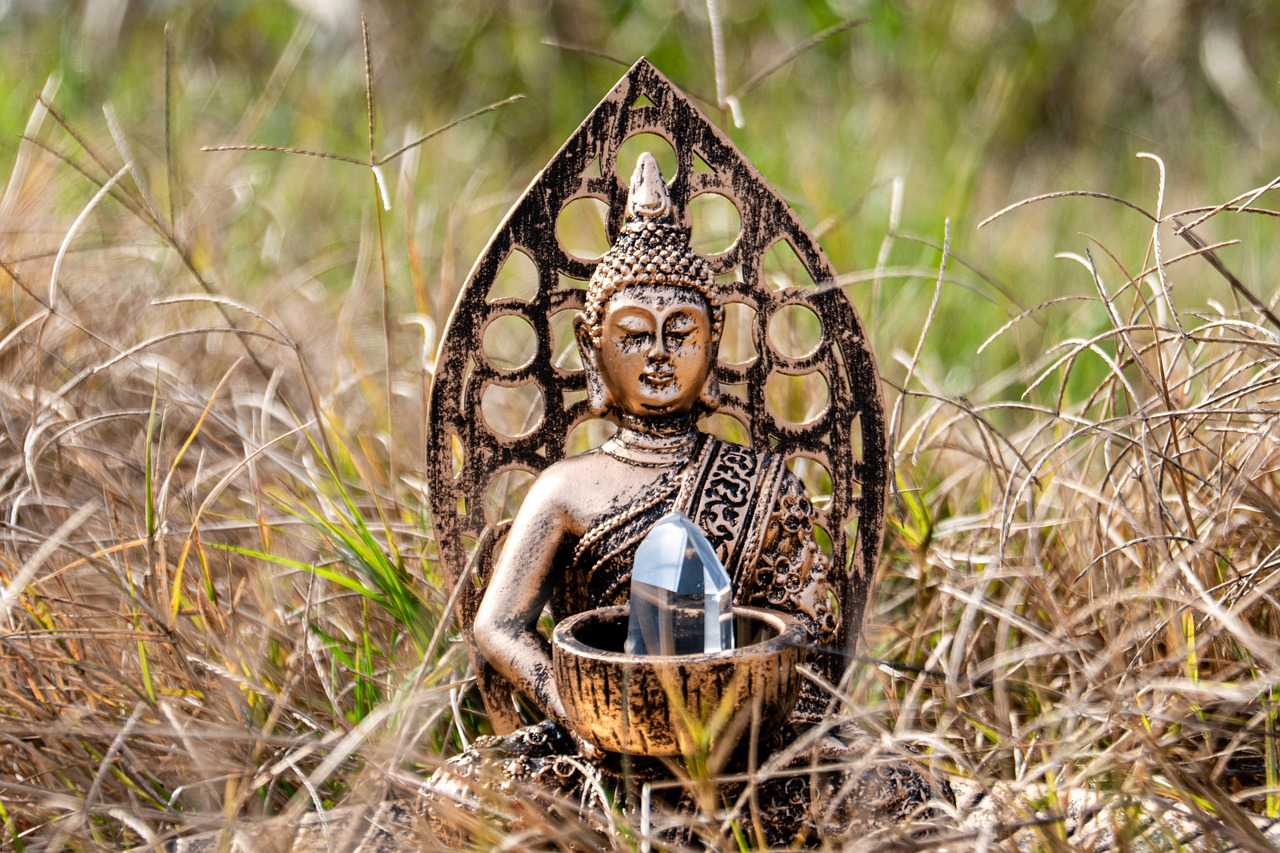
Mindfulness and Relaxation Techniques
In the whirlwind of chaos that accompanies disasters, finding a moment of peace can feel like searching for a needle in a haystack. However, serve as powerful tools to help us reclaim our calm amidst the storm. These practices not only ground us but also allow us to reconnect with our inner selves, fostering a sense of clarity and serenity. Imagine standing on a beach, the waves gently lapping at your feet, while the sun sets in a blaze of orange and pink. This mental imagery can be a starting point for mindfulness, where you can visualize tranquility even when reality feels turbulent.
One of the simplest yet most effective mindfulness techniques is focused breathing. This involves taking deep, intentional breaths—inhale through your nose for a count of four, hold for four, and exhale through your mouth for another four. This rhythmic pattern not only calms your nervous system but also anchors your thoughts, pulling you back from the brink of anxiety. You can practice this technique anywhere, whether you’re in a crowded shelter or your own home, making it a versatile tool in your mental health toolkit.
In addition to focused breathing, meditation is another excellent way to cultivate mindfulness. Even just a few minutes a day can yield significant benefits. You might start by finding a quiet space to sit comfortably, closing your eyes, and focusing on your breath. If your mind starts to wander—because let's face it, it will—gently guide your attention back to your breath. Over time, this practice can enhance your ability to manage stress and anxiety, helping you feel more grounded and centered.
To further enrich your mindfulness practice, consider incorporating guided imagery. This technique involves visualizing a peaceful scene, like a serene forest or a tranquil lake. You can enhance this experience by engaging your senses—what do you see, hear, and feel in this safe space? Creating a mental escape can be incredibly healing, especially during times of crisis.
Moreover, yoga combines physical movement with mindfulness, making it a fantastic way to release tension and promote relaxation. Even gentle stretches can help alleviate physical stress, while the focus on breath encourages a state of calm. You don’t need to be a seasoned yogi; simple poses like Child's Pose or Cat-Cow can be practiced at home, providing both physical and mental relief.
It's essential to remember that mindfulness and relaxation techniques are not one-size-fits-all. Each individual may find different methods resonate with them. Here’s a quick table summarizing various techniques you can try:
| Technique | Description | Benefits |
|---|---|---|
| Focused Breathing | Deep, intentional breaths to calm the nervous system. | Reduces anxiety, increases focus. |
| Meditation | Quiet reflection to enhance self-awareness. | Improves emotional health, reduces stress. |
| Guided Imagery | Visualizing peaceful scenes to promote relaxation. | Enhances mood, reduces feelings of distress. |
| Yoga | Physical postures combined with breath control. | Relieves tension, improves physical health. |
Incorporating these mindfulness and relaxation techniques into your daily routine can significantly enhance your ability to cope with stress and anxiety during disasters. Remember, the goal is not to eliminate stress completely but to develop a healthier relationship with it. By embracing these practices, you can cultivate a sense of resilience that will serve you well in challenging times.
- What is mindfulness? Mindfulness is the practice of being present and fully engaged in the moment, without judgment.
- How can I start practicing mindfulness? Begin with simple techniques like focused breathing or short meditation sessions.
- Is yoga necessary for mindfulness? No, yoga is just one of many techniques; you can practice mindfulness without it.
- How often should I practice these techniques? Daily practice, even if just for a few minutes, can be beneficial.

Seeking Professional Help
In times of disaster, it’s not uncommon for individuals to feel overwhelmed by their emotions, leading to an urgent need for support. Recognizing when to seek professional help is a crucial step in managing stress and anxiety effectively. It’s essential to understand that reaching out for help is not a sign of weakness; rather, it demonstrates strength and a commitment to your mental well-being. Just as you would consult a doctor for a physical ailment, a mental health professional can provide the necessary tools and strategies to navigate emotional distress.
When considering seeking professional help, it's important to identify the signs that indicate you may need additional support. Symptoms can include persistent feelings of sadness, excessive worry, difficulty concentrating, and changes in sleep or appetite. If these feelings linger and begin to interfere with your daily life, it might be time to talk to someone who can help. Remember, you are not alone in this journey; many people experience similar feelings during and after disasters.
There are various types of mental health professionals available, each offering different approaches to treatment. Here’s a quick overview:
| Type of Professional | Specialization |
|---|---|
| Psychologist | Focuses on therapy and mental health assessments. |
| Psychiatrist | Can prescribe medication and provide therapy. |
| Licensed Counselor | Offers guidance and support through talk therapy. |
| Social Worker | Helps connect individuals to resources and provides counseling. |
Finding the right professional can feel like a daunting task, but it’s essential to take the first step. Reach out to your primary care physician for recommendations, or consult community resources that specialize in mental health support. Many organizations offer hotlines and online therapy options, making it easier than ever to access help. Don't hesitate to ask questions during your first meeting to ensure you feel comfortable with the professional's approach and philosophy.
Additionally, consider the possibility of group therapy. Engaging with others who have faced similar challenges can foster a sense of community and understanding. Sharing your experiences in a safe environment can be incredibly therapeutic and may help you realize that you’re not alone in your feelings. Remember, seeking professional help is a proactive step toward healing and resilience. It’s about equipping yourself with the tools necessary to navigate the emotional aftermath of a disaster and emerge stronger.
Ultimately, your mental health is just as important as your physical health. By prioritizing it and seeking the necessary support, you are taking a significant step towards recovery and well-being. So, if you find yourself struggling, don’t hesitate to reach out—help is available, and you deserve it.
- When should I seek professional help? If your feelings of anxiety or stress persist for weeks and affect your daily life, it's time to consult a mental health professional.
- What should I expect during my first therapy session? Your therapist will likely ask questions about your feelings, experiences, and any specific issues you want to address. This is a time for you to share and get to know each other.
- Are there online therapy options available? Yes, many platforms offer virtual therapy sessions, making it easier to access help from the comfort of your home.
- How do I find a therapist? You can start by asking your doctor for recommendations, searching online directories, or looking into community mental health resources.
Frequently Asked Questions
- What is the difference between stress and anxiety?
Stress is a response to an external trigger, like a disaster or a deadline, causing feelings of tension or pressure. Anxiety, on the other hand, is more about persistent worries and fears that often don’t have a clear cause. Understanding this difference can help you identify how you’re feeling and what you need to cope.
- How can I recognize symptoms of stress and anxiety during a disaster?
Common symptoms include irritability, difficulty concentrating, sleep disturbances, and physical symptoms like headaches or stomachaches. If you notice these signs in yourself or others, it's important to acknowledge them and seek support.
- What are some effective self-care strategies to manage stress?
Engaging in regular physical activity, practicing mindfulness or meditation, maintaining a healthy diet, and establishing a consistent sleep routine can significantly reduce stress levels. Remember, taking care of your body is just as important as taking care of your mind!
- How does community support help during stressful times?
Community support can provide a sense of belonging and shared experience, which is crucial during disasters. Connecting with others allows you to share feelings, gain different perspectives, and access resources that can help you cope better.
- When should I seek professional help for stress and anxiety?
If your symptoms are overwhelming, persistent, or interfere with your daily life, it’s time to reach out to a mental health professional. They can provide tailored strategies and support to help you navigate through tough times.
- What role does mindfulness play in managing anxiety?
Mindfulness helps you stay present and focused, reducing the tendency to ruminate on stressful thoughts. Techniques like deep breathing or guided meditation can calm your mind and promote relaxation, making it easier to handle anxiety.
- Can disasters lead to long-term mental health issues?
Yes, experiencing a disaster can lead to long-term issues such as PTSD or chronic anxiety. It’s important to recognize the potential for these effects and seek ongoing support if needed.
- What are some common reactions to disasters?
Following a disaster, it’s normal to feel shock, confusion, or fear. These reactions are part of the human experience, and acknowledging them is the first step towards healing and resilience.


